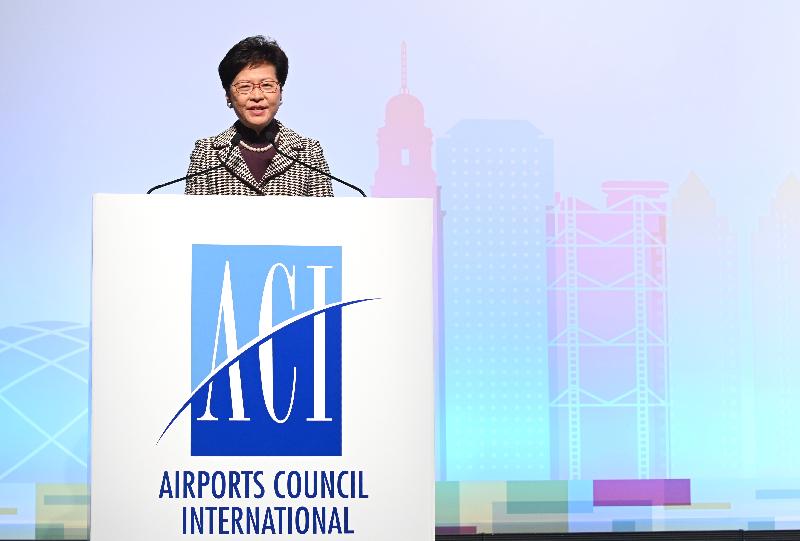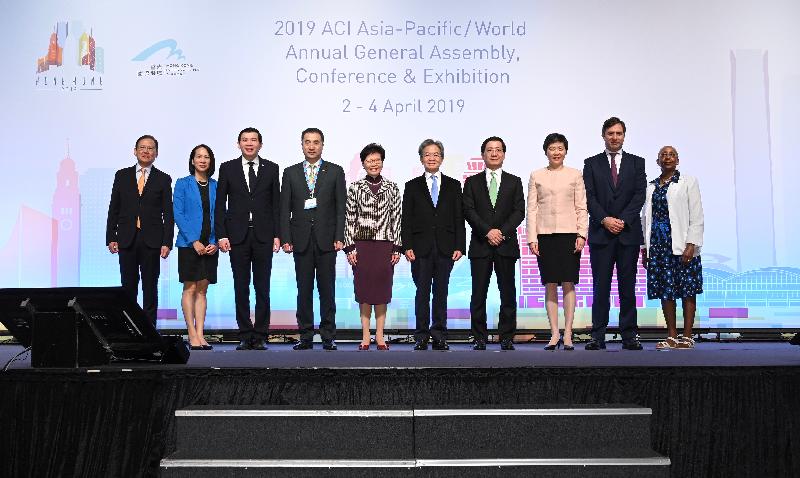Following is the speech by the Chief Executive, Mrs Carrie Lam, at the 2019 Airports Council International (ACI) Asia-Pacific/World Annual General Assembly, Conference & Exhibition today (April 3):
Martin (Chair, ACI World Governing Board, Mr Martin Eurnekian), Mr Lee (President, ACI Asia-Pacific, Mr Lee Seow Hiang), Dr Liu (Secretary General, International Civil Aviation Organization, Dr Liu Fang), Jack (Chairman of the Airport Authority Hong Kong, Mr Jack So), Fred (Chief Executive Officer of the Airport Authority Hong Kong, Mr Fred Lam), Dr Dong (Deputy Administrator of the Civil Aviation Administration of China, Dr Dong Zhiyi), ladies and gentlemen,
Good morning. We are honoured to be hosting for the very first time the Airports Council International's World General Assembly, one of the highlights in the global aviation industry's annual calendar. This event brings to Hong Kong hundreds of the global aviation industry's leaders. On behalf of the Hong Kong SAR Government, let me extend to you a very warm welcome.
Being the headquarters for ACI Asia-Pacific, which represents over 100 members operating nearly 600 airports in 49 countries and regions, Hong Kong is well placed for ACI's Annual General Assembly. Our world-class airport, the Hong Kong International Airport, is amongst the best in the world. Last year, our airport achieved recording-breaking performance by handling more than 74 million passengers and over 5 million tonnes of cargo and air mail. That made Hong Kong the world's busiest cargo airport for the eighth year in a row. We are, as well, the world's third-busiest international passenger airport.
Aviation leaders are coming at a time when we are gearing up to play an even more important role in the airport business. The construction of a three-runway system for the Hong Kong International Airport began in August 2016, with commissioning of the third runway scheduled for 2022. Together with a new passenger building, a new automated people mover, a new baggage handling system and expansion of the existing Terminal 2 into a full-service processing terminal, this whole three-runway system will come into operation in 2024. When it's up and flying, the revamped airport will be able to accommodate 620 000 flight movements annually, welcoming about 100 million passengers and handling some 9 million tonnes of cargo a year.
Realising those numbers will set the entire Hong Kong aviation sector soaring to unprecedented heights. No less important, it will benefit our entire community. Our Airport Authority expects that the three-runway system will create some 123 000 jobs directly, plus another 165 000 jobs either indirectly or through induced employment.
Hong Kong International Airport connects with more than 220 destinations worldwide. That includes over 50 cities in Mainland China, one of the world's fastest-emerging aviation markets. Mainland aviation has been a particular focus here recently, thanks to the promulgation of the Outline Development Plan for the Guangdong-Hong Kong-Macao Greater Bay Area. The Greater Bay Area brings together a cluster of nine cities in the Guangdong Province, together with Hong Kong and Macao, the two Special Administrative Regions of the People's Republic of China. A collective economic powerhouse in the making, the Greater Bay Area currently has a population of 70 million and a combined GDP of US$1.6 trillion.
The Greater Bay Area development is premised on the complementarity of the respective advantages of the 11 cities in the region. In Hong Kong's case, amongst other things, we will play the leading role as an international aviation hub. Blessed by the Outline Development Plan, as well as the "one country, two systems" principle, Hong Kong will strive to maintain our airport's leading status in the region, and enhance our services through innovative measures, such as inter-modal code-sharing services.
The recent expansion of the intermodal code-sharing arrangement will bring about plentiful opportunities in the years ahead. It enables travellers to use the same air ticket to continue with their journeys to different Mainland destinations or vice versa by ferries, coaches or trains. The Intermodal Transfer Terminal project, to be completed by 2022, will provide passengers with hassle-free connections from the Hong Kong-Zhuhai-Macao Bridge to our boarding gates.
Our airport is also embracing autonomous vehicles, robotic-serving devices, facial recognition technology and much more. It's determined, as well, to become the world's first airport equipped with a 5G communications network.
Innovative technology demands equally innovative talent. In that regard, the Hong Kong International Aviation Academy, established in 2016, has already trained more than 10 000 industry participants. The programme, I should add, works not only with Hong Kong people but aviation industry students and practitioners around the world. In particular, the Academy can help train students from countries along the Belt and Road and contribute to their capacity building.
With our airport sitting right at the heart of the "double gateway" connecting to the Greater Bay Area at one end and to the world at the other, Hong Kong offers seamless air-to-land and air-to-sea connections with a huge number of nearby destinations. It makes perfect sense to leverage on the unique advantage of our airport to foster a wider network of inter-related business activities. Indeed, our vision is to engineer our city's airport to become an Aerotropolis with high economic efficiency and diversified employment opportunities, so as to enhance Hong Kong's position as an international business centre. The development of this Aerotropolis is in line with worldwide trends, and we are embarking on various novel and exciting developments to make this happen.
Our SkyCity is one of the key economic locomotives, which will spin off enormous opportunity with the infrastructural developments in the proximity. We envisage the SkyCity to become one of the largest commercial developments in Hong Kong providing a full suite of hotel, retail, dining and entertainment facilities. It is destined to be a destination of its own – serving local residents as well as visitors from overseas and the Greater Bay Area.
There is more – this very facility where I am standing right now, the AsiaWorld-Expo, is exploring its next phase of development to meet the growing demand for exhibitions and events. A high-end logistics centre covering an area of approximately 5.3 hectares at the southern cargo area of the airport is also being developed, which is expected to be in operation in 2023. Looking further ahead, the topside of the Hong Kong Boundary Crossing Facilities island of the Hong Kong-Zhuhai-Macao Bridge will be put to good use. There will be tremendous synergies among these developments in the making of our visionary Aerotropolis.
In short, ladies and gentlemen, there are exciting times ahead for our airport. I would invite you all to come visit again in future, and see for yourselves how we turn all these promises and visions into reality.
My thanks once again to the ACI for choosing Hong Kong as the host for this annual assembly. I wish you all the best of business at the conference and a very enjoyable stay in Hong Kong. Thank you very much.
Follow this news feed: East Asia







